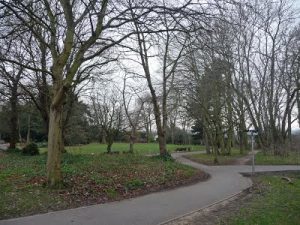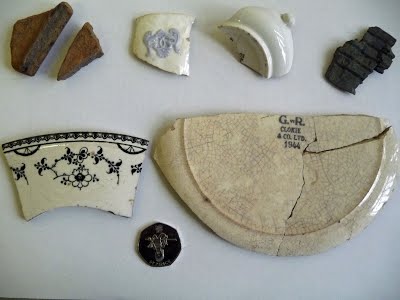
No. 505 APRIL 2013 Edited by Peter Pickering
H A D A S D I A R Y – Forthcoming Lectures and Events.
Lectures are held at Avenue House, 17 East End Road, Finchley, N3 3QE, and start promptly at 8 pm, with coffee/tea and biscuits (£1) afterwards. Non-members: £1. Buses 82, 125, 143, 326 & 460 pass nearby and Finchley
Central station (Northern Line), is a short walk away.
Tuesday 9th April 2013: Nautical Archaeology – past, present and future. Lecture by Courtney Nimura & Eliott Wragg.
Courtney Nimura is a PhD Candidate at the University of Reading studying prehistoric maritime rock art in Scandinavia. She previously worked at the Museum of Fine Arts, Boston (USA) in Conservation and Collections Management before returning to university in the UK. Courtney has a BA and MFA in photography / museum studies from the United States, and an MA in Maritime Archaeology from the Institute of Archaeology at University College London. Alongside her work with the Nautical Archaeology Society, she works for the Thames Discovery Programme in London.
Eliott Wragg has a BA in Ancient History and Archaeology and a Post-Graduate Diploma in Field Archaeology, both from Birmingham University and an MA in Maritime Archaeology from UCL. He worked as an Archaeological Site Assistant for the Birmingham University Field Archaeology Unit and Pre-Construct Archaeology before becoming a Senior Archaeologist for the latter and then going on to work as a freelance site supervisor and project manager on sites in the South-East of England. He is currently the Field Officer for the Thames Discovery Programme and has a particular interest in vessels and vessel fragments.
Tuesday 14th May 2013 – 10,000 years of History beneath your Feet: The Bankside Foreshore. Lecture by Dr Fiona Haughey.
1st June 2013 Foreshore Walk – Following her talk, Dr Haughey has offered to give us a tour of the foreshore of the river by Bankside and the Tate Modern, numbers permitting. The walk will take about two hours and cost £5 per person. The date has been chosen because then the tide is most suitable. The idea is we meet at the Millennium Bridge, south side, in front of the Tate Modern ready to leave at 13.30. The walk will take place provided there are at least 15 participants (the maximum number is 20) and it will be first come first served. Contact Don Cooper telephone 020 8440 4350, e-mail: chairman@hadas.org.uk
Tuesday 11th June 2013 -Annual General Meeting.Sunday 15th to Thursday 19th September 2013 – Buxton Trip
We now have sufficient members signed up for our trip in September based in Buxton, Derbyshire to make the trip viable. See February newsletter for details. It would still be nice to have a few more.
Our selected hotel should provide comfort for all, with excellent company provided by other HADAS members. If you are interested but have not yet signed up, please contact Jim or Jo Nelhams (see last page for contact details).
Tuesday 8th October 2013 – Brunel’s Tunnel under the Thames. Lecture by Robert Hulse, Director of the Brunel Museum.
Tuesday 12th November 2013 – Lions on Kunulua – excavations of Early Bronze and Iron Age periods at Tell Tayinat, Hatay, Turkey. Lecture by Dr Fiona Haughey.
Sunday 1st December 2013 – Following our enjoyable Christmas event in the last two years, we have again booked Avenue House. The “party” will run from roughly 12:00 to 4:30. More details in due course.
‘The Archaeology of the First Peoples into North America.’ course by Peter Nicholson
The Mill Hill Archaeological Study Society is running a course of six classes with this title. The course will examine the archaeology of the first of the native peoples into North America. We will investigate theories regarding the entry and date via the Bering Strait and routes available to the newcomers from Alaska and the Yukon. The Clovis and then Folsum expansion into the Great Plains will be dealt with as will the possible human causes of the megafauna extinction. Questionable sites and theories will be covered along with the latest theories concerning language and DNA. Finally we will study the problems of working with living indigenous peoples and their attitude to archaeology and the excavation of burial sites. The course tutor is Scott
McCracken. The course is on Friday mornings from 10 to 12, beginning 19th April, in the Eversfield Centre, 11 Eversfield Gardens, Mill Hill, NW7 2AE. The cost for the course will be £40. Enrol at the first meeting; if you have not previously attended the Society’s meetings please contact the secretary, Peter Nicholson (020-8959 4757).
CBA Winter meeting at York on 2nd & 3rd March 2013 by Don Cooper
This meeting was themed as a forum on the ‘Role of local societies in archaeology in the 21st century’. Representatives of a large number of societies, both county level societies and small local ones, attended. It was interesting that the activities of large and small societies were very similar, namely: A winter lecture series for members, outings in the summer, small scale excavations and fieldwalking, newsletters or leaflets (various frequencies from monthly to once a year), training in the form of one day courses all the way to full 22 week ones, and social and fund-raising events. Most societies do their best to ‘defend’ local heritage, but find it difficult to mobilise support in strength.
The issues facing the societies are also very similar: a declining and ageing membership, increased cost of communication with members (publishing newsletters, postage etc.), and very few active members, (for instance, a number of societies have stopped doing outings as there was no one to run them).
A major challenge is technology and multi-media with many of the more senior members of societies finding that receiving information such as newsletters by email, electronic payment for subscriptions, using web sites, Facebook, blogspots and Twitter, difficult to understand and use. As a consequence the gradual change over to online media from paper and posted mail is and will be more difficult and expensive for local societies.
In these challenging times, partnerships with other heritage societies as well as non-heritage societies offer an opportunity to pursue local goals more effectively and ‘beef-up’ the strength of advocacy in defence of heritage.Overall the forum enabled an exchange of ideas on the strengths, weaknesses and opportunities and threats facing local and county societies and provided an opportunity for establishing inter society relationships.
February Lecture – Can you tell a Longboat from a Log Boat? Tessa Smith
I think I can now, thanks to the lecture entitled “From Logboat to Warrior – Evolution of the Wooden Ship” given by Eliott Wragg – Field Officer of the Thames Discovery Programme.
Eliott steered us expertly at a rate of knots from skin boats to log boats to clinker-built boats, from the introduction of masts, sails, paddles and rudder, from river and estuary boats to sea-worthy ships and from fighting and merchant types made entirely of wood to the rise of the iron ship.
One of the earliest boats mentioned in the lecture was the Hasholme Iron Age logboat made around 300 BC from a single large hollowed oak tree dug out by hand or burned out by fire and made watertight by a mixture of moss and twigs. It had a small shelf at one end and would have been manoeuvred by a pole.
The Dover bronze age boat is much older, dating from 1500 BC, the middle bronze age. It is one of the world’s oldest known sea-going boats. It was excavated in 1992 and I remember the excitement in the press at the time, so much so that Sheila Woodward and I organised a HADAS outing to Dover to see it in the museum’s spectacular new gallery. It was impressive, made using four huge oak planks sewn together with yew lashings, a technique which was clearly visible to us.
The oldest archaeological find of a wooden Nordic boat is the Hjortspring, built about 350BC, the oldest known boat to use clinker planking, where the planks overlap one another. Later designs had stronger keels and the hull was reinforced by oak stathes joined by iron rods – boats were becoming more sea-worthy.
The Anglo Saxon early 7th century burial ship at Sutton Hoo is a longboat (in fact 90 feet long) and is a fast shallow draft vessel, but there is no evidence of sail or mast. But the Oseberg Viking longboat built around 820AD has a mast holder for a square wooden sail amidship; it is the biggest Viking longboat ever found, a massive 36 metres, 4 metres longer than the Mary Rose.
During the middle ages ships became more seaworthy both for fighting and carrying cargo. The development of masts and sails meant that the ships were no longer dependent on oarsmen and could travel vast distances using wind power.
Fighting castles were added fore and aft as in the Grace Dieu built in 1418 for Henry V, and the Mary Rose built in 1511 for Henry VIII, carrying heavier and more powerful guns. Extraordinary ornamentation carvings and gilding were added, evoked for us by paintings of ships in full sail, dipping, turning and wheeling.
To this day it is not entirely clear how the ship wheel evolved during the 18th century, but it was a huge technical breakthrough, controlling the rudder by a series of block and tackle, gear wheels, cogs and chains.
With the development of ironclad wooden boats and ships made of iron, wooden boats could not compete. In1843 Brunel’s Great Britain became the first iron steamer to cross the Atlantic; in 1860 Warrior became the first entirely iron boat, thus initiating the decline of the age of magnificent great wooden ships.
Eliott steered us expertly back to harbour, somewhat breathless through our journey by wooden boat, many, many of which had sunk, and as he said ‘it was very convenient for us – all those boats sinking.’
Current Archaeology Conference Peter Pickering
I attended Current Archaeology’s annual conference on 1st and 2nd March. Like last year, it was in the University of London Senate House, and the Beveridge Hall, which holds 450, was well filled, very largely, I judged, with Current Archaeology readers from outside London. The programme included reports on important recent excavations.
From the prehistoric age we learnt of some very grand Neolithic structures at the Ness of Brodgar (with traces of colouring), which would have graced the prehistoric Mediterranean; of the nine bronze age river boats at Must Farm (quite near Flag Fen); and of the colossal hill fort (the largest in Britain and four times as big as Maiden Castle) at Ham Hill Somerset.
There were three talks on Roman Britain. Keith Parfitt brought us up to date on the Folkestone Roman Villa with its important but previously unknown Iron Age predecessor (memorably visited by HADAS in 2011); it was good to learn that further work there is planned this year, since the whole site will sooner or later fall into the sea. Andrew Birley talked about Vindolanda, a very popular site for volunteers; he showed us two pieces of beautiful painted glass from Cologne which were found in different parts of the site, but which fitted together. The division between military and civilian in Vindolanda became blurred in the fourth century, and activity seems to have continued in some form long after the end of Roman rule. Ian Haynes talked about the strange case of the Maryport altars, unearthed from pits by antiquarians in the nineteenth century and long believed to have been buried deliberately each one in advance of the dedication of the next, but which now appear to have been used as filling for pits holding structural timber uprights of a late building (perhaps related to some post- Roman tombstones inscribed in Latin).
There were three reports on community projects on Anglo-Saxon villages. The cemetery in Oakington, Cambridgeshire, has produced several intriguing burials, including two with horses, one with a cow and one with a spoon – thought to have been a weaning spoon. The exploration of the cemetery is being complemented by small digs around the village, to improve knowledge of the settlement. The Lyminge Archaeological Project is investigating a settlement that was of high status before the conversion to Christianity (with a large timber hall) and became a double monastery (monks and nuns), with a great quantity of fish bones. Neil Faulkner has a long-running project at Sedgeford in Norfolk, but is concerned by the lack of a conceptual framework for Anglo-Saxon settlements like that for the Roman period, with towns, villages, villas and forts; he believes that archaeology can produce that framework, and gave an account of Anglo-Saxon history as evolution from small egalitarian settlements to feudal villages dominated by thegns and the church.
For later times we had Richard Buckley on Richard III; Heather Knight on the Curtain Playhouse, revealed by MOLA (Museum of London Archaeology) and to be preserved in some way as that area of Shoreditch is redeveloped; Pieta Greaves on the conservation of the Staffordshire Hoard; and the osteologist Don Walker on the evidence of mass fatalities from the Spitalfields cemetery, which he believes point to a famine attributable to the effect of a volcanic eruption (perhaps in South America) in 1258.
There was also a whole session on Herculaneum and Pompeii, in preparation for the exhibition at the British Museum, and talks on Operation Nightingale (archaeology by wounded service personnel) and on the rescue archaeology of the National Roads Authority of Ireland.
AND WE’VE GOT JUST THREE DAYS TO DIG IT…HENDON TOWN HALL CAR PARK
EXCAVATION, 1978 Andy Simpson
Having looked recently at the Hendon Fuller Street and White Swan Golders Green excavations from the HADAS back catalogue of unpublished excavations, we return once again to Hendon.
Back during the Bank Holiday weekend, 26-28th August 1978, the late Ted Sammes directed another dig in central Hendon to add to those in Burroughs Gardens (1972), Church Terrace (1973/4) and Fuller Street (1974). This was on the perimeter of the far end of car park which lay between the Town Hall and the public gardens of the Grove. As the April 1978 HADAS newsletter recorded, the object was ‘to test the area so that we will have a better idea of whether or not a larger dig should take place before the proposed extension of the Town Hall gets under way in a year or two’s time’. The August 1978 HADAS newsletter further noted ‘This will be a short exploratory dig, directed by Ted Sammes, to assess the archaeological potential of the area prior to a proposed development by Barnet Borough Council’
Hendon Town Hall lies at the centre of the Burroughs, standing on the west side just south-east of the former Grove House site where the Victorians had found some evidence of Roman Hendon; it was originally part of the Grove grounds, as shown in Cook’s map of 1796, sitting just at the SE corner of the grounds. With the foundation stone laid on the 10th October 1900 and a formal opening on 13th November 1901, Hendon Town Hall itself, built in the grounds of Grove House, was completed from designs by T.H. Watson, serving as the offices of the then Hendon Urban District Council, being extended at the back in 1934 when ‘an extensive enlargement was completed’, according to the brochure for the Hendon Borough Show Civics Exhibition 1952. It became Hendon Town Hall in 1932 when Hendon became a Municipal Borough, and now has a modern extension to Middlesex University standing right behind it. The University now leases most of the Town Hall building itself also, except for the council chamber.
GROVE HOUSE AND GROUNDS
Grove House itself, a large stuccoed two-storey building built by 1753, sited to give commanding views westwards towards Harrow and north to Mill Hill, and substantially rebuilt in the 19th century and later, successively, a private nursing home and mental home, was demolished in 1934 following purchase by Hendon Council. The now-levelled site of the house and part of its grounds survive as a small public park called The Grove at the rear of the Fire Station and University, with the original entrance avenue which led directly to the house still extant between University buildings now leading to the park and site of the house. In the Grove grounds in late 1889 in the area of the former Technical College playing fields – the present Middlesex University – were found fragments of Roman pottery including cremation urns, a complete flagon, and building material (including two bricks and flanged roofing tile) and bone fragments.
The Grove House grounds were further reduced by the building of the still-extant adjacent Fire Station in 1914 and the neo-Georgian library in 1929, along with Hendon College of Technology in 1939 – now the main campus of Middlesex University – being extended in 1955 and 1969 (mainly on former Church End Farm land).
Photo – Grove Gardens February 2013,
Grove House stood on the central flat area until 1934.
Further work near the Grove House site took place when in May 1995, the South East London Archaeological Unit undertook a watching brief at the Hendon Campus of Middlesex University, which showed that extensive terracing had removed any possible archaeological evidence, and no dating evidence was recovered from the single feature exposed, a broad hollow. Further archaeological evaluation work at the Hatchcroft development on the Burroughs, Hendon in 2007 (TQ2276 8929, site code HCF07) in five trenches found only post-medieval features and an undated ditch, possibly landscaping associated with the construction of Grove House in 1753.
Also, in November 2002 prior to new construction work, AOC Archaeology opened up four trenches in the former car park site (TQ2275 8940) at Middlesex University down Greyhound Hill opposite the entrance to Sunny Hill Park. The trenches cut through modern tarmac and down through made ground to a depth of two metres, being opened on a Tuesday and backfilled the following morning after nothing was found except the site of a possible pond at the top end of the site and natural gravels cut by possible palaeochannels.
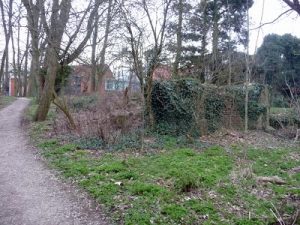 Photo – Extant Brickwork, rear of Grove Gardens, February 2013 – Grove House outbuilding footings?
Photo – Extant Brickwork, rear of Grove Gardens, February 2013 – Grove House outbuilding footings?
(Now supporting park steps)
THE TOWN HALL EXCAVATION
Four trenches were dug, at the south and west sides of the car park, lettered A through to D. No original site records, plans or sections appear to have survived, but if anyone knows otherwise we will be delighted to hear from them! Although it was originally thought the dig might continue into September, the three days of the August Bank Holiday were in the end thought enough.
All we have are three annotated copies of a black and white group portrait of five of the diggers taken during backfilling of a trench adjacent to a tall brick boundary wall on 9th September 1978, and four different colour print snapshots taken by the late George Ingram on Sunday 27th August 1978 which concentrate on people rather than features, centered on the deep, narrow trench being backfilled in the later B/W photo. The one photo showing the trench sides indicates a considerable amount of brick rubble in the very dark humic make-up.
There are some references in the annual London Archaeologist excavation round-up and HADAS Committee minutes for June and September 1978, however, along with the original finds.
The site was located at Grid reference NGR TQ22608920 (London HER record no. 081978/00/00. The excavation team included Ted Sammes, Percy Reboul, Jeremy Clynes, Raymond and Christopher Lowe and George Ingram.
It was found that the site had been levelled by twentieth-century dumping; beneath this eighteenth and nineteenth century pottery, clay tobacco pipes and modern field drains were discovered, along with two small conjoining sherds of medieval pottery.
To quote the September 1978 HADAS Committee minutes; ‘Four trenches were opened. One produced nothing but wood blocks for road work (none of which seem to have been retained – AS); one (Trench B) produced Victoriana with one residual piece of medieval pottery (broken in two- later confirmed as London Ware – AS). The others (trenches C and D) produced field drains. A gravel path, shown on the 19th century estate map, was found. Three small yellow bricks, similar to those found on other nearby sites, came from the immediate Town Hall/Grove Gardens area.
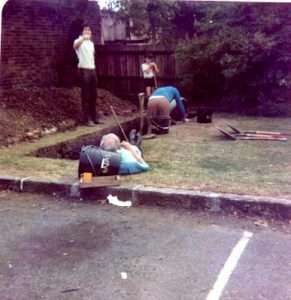 There is no mention of whether the natural was reached or not. A later exhibition caption states that the dig ‘came, through lack of evidence, to no definite conclusion. The site was, in fact, virtually sterile.’
There is no mention of whether the natural was reached or not. A later exhibition caption states that the dig ‘came, through lack of evidence, to no definite conclusion. The site was, in fact, virtually sterile.’
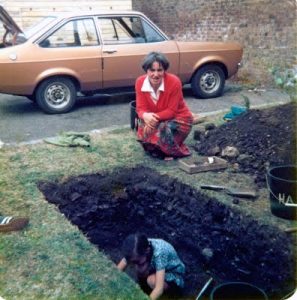 Ted Sammes (reclining) supervises operations whilst Jeremy Clynes points at the camera… and is that Percy Reboul with his back to the camera? (George Ingram photo)
Ted Sammes (reclining) supervises operations whilst Jeremy Clynes points at the camera… and is that Percy Reboul with his back to the camera? (George Ingram photo)
Ford Cortina (Mk II?) – and Mum – with only known photo of actual section. (George Ingram photo) THE TRENCHES
Trench A appears to have been dug in four distinct spits in the absence of recognisable contexts in the dump make-up, up to a recorded depth of 60cm. Finds were a piece of building plaster, clay pipe fragments, most of the post-medieval – medieval pottery recovered from the site – mostly refined white wares – and glass (bottle- neck and ‘OXO’ jar), a bone toothbrush handle, a glass marble, a Yale key, a bottle top marked ‘3d Deposit on Bottle’, and a latch-plate from a lock.
An unusual find is a piece of shrapnel, probably 3.7-inch artillery shell, seemingly complete with driving band (which engaged with the rifling of the gun barrel to spin-stabilise the shell) – possibly originating from local Second World War heavy anti-aircraft (AA) sites.
Research kindly undertaken by my colleague Andy Renwick, Curator of Photographs at the RAF Museum, indicates that battery ZW13 was in Mill Hill (TQ 218 945) and ZW14 was in West Hendon (TQ 211 881). Both were equipped with the 3.7″ anti-aircraft gun – an example of which is displayed in the Battle of Britain Hall at the RAF Museum Hendon.
There was also an Anti-Aircraft Flight which was based at RAF Hendon until June 1942. This could have been equipped with 40mm Bofors and these were the guns deployed in the grounds of the Met Police Training School in Aerodrome Road and Sunny Hill Park overlooking RAF Hendon itself.
In March 2013, local resident Dennis Weston kindly provided the following recollection of his time as a teenage fire-watcher at the Town Hall:
‘In 1943, on leaving school, I started work in the wages department of the local council at Hendon Town Hall, working normal office hours of 9am to 5pm. To provide extra assistance to the ARP services, a volunteer group of Town Hall employees, working on a shift basis, provided a group of fire-watchers specifically for the protection of the Town Hall building. A group of six employees commenced duties after normal office hours until the following morning’s normal start time. At various points along the corridors were buckets of water and sand, checked on a daily basis. Once an air raid siren had been heard, routine checks were made to all floors of the building.’
‘On evenings when no air raid sirens had sounded, the Town Hall volunteers had access to a games room with a full sized snooker table and use of a substantial kitchen with equipment to make tea and toast. Should no air raid siren be sounded during the whole night, camp beds were provided in one of the corridors for the volunteers to snatch a few hours’ sleep as they were expected to resume normal duties in the office the next day. A small expense allowance was paid for each night’s duty and for an office junior this was a welcome addition!’
‘My outstanding memory relates to the night of September 1940 when a group of us on duty stood on the roof of the Town Hall and watched in horror the crimson glow of the fires raging in the city of London’
Trench B, dug to a depth of 50cm, yielded two conjoining base sherds of medieval pottery – London Type Ware (LOND) – dated 1080 – 1350 – the only medieval find from the site. In addition there was a considerable quantity of post-medieval pottery, again, mostly refined white wares.
Trench C, dug to 40cm, yielded post-medieval pottery including a complete stoneware inkpot, clay pipe fragments, a glazed tile, and four lengths of modern field drain.
Trench D yielded just two more lengths of modern field drain.
THE FINDS
The finds were fully sorted and recorded using standard MOLAS recording forms.
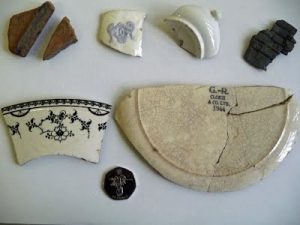 Selection of finds, including medieval London ware top left, artillery shell fragment (with driving bands) top right, 1942 cup fragment to left of shrapnel. 50 pence piece as scale.
Selection of finds, including medieval London ware top left, artillery shell fragment (with driving bands) top right, 1942 cup fragment to left of shrapnel. 50 pence piece as scale.
Pottery
Apart from the two pieces of medieval pottery referred to above, the majority of the pottery found was Victorian or more recent – much of it refined white ware (REFW, 1800 – date), of which some has transfer decoration.
Some of it at least appears to be ‘Government issue’ – one sizable piece of plate from Trench A being marked on the base ‘G.VI.R Clokie & Co Ltd 1944’ A cup fragment appears to have (19) 42 on the base. Perhaps these are related to Home Guard or other use – the roof of the Town Hall was certainly a fire-watching post during World War Two.
English Porcelain (ENPO, 1740s onwards) and English Stonewares (ENGS) are also present, plus late tin-glazed ware (TGW) and Post-Medieval Redware (PMR, 1580 – 1900) and Transfer-Printed wares (TPW). Identifiable fragments include an R.White’s stoneware ginger beer bottle.
Clay Pipe
Only trenches A and C yielded any clay pipe remnants – a total of 15 stem fragments and five bowls, or parts thereof. Of the latter, only three were complete enough to be datable – one each of types AO28, 29 and 30 – their date ranges being 1820-1860, 1840-1880 and 1850-1910 respectively. Additionally, one undated stem and spur fragment had a shield design either side of the spur, and an incomplete bowl had a dot design either side of the front seam.
Building Material
This mostly consisted of lengths of modern field drain and some bricks.
Trench C had yielded four 30cm (one foot) field drain lengths, one incomplete. Their average external diameter was 6cm/2.5 inches. A further two similar lengths came from Trench D.
Unstratified from the adjacent Grove Gardens came five yellow bricks, original average length 180mm, depth 37mm, two of them incomplete. These are likely to be hand-made ‘Dutch’ bricks of late sixteenth/ seventeenth century date, of which a number have been found in the Hendon area.
There was also one glazed half-brick, 72mm long and 36mm deep, glazed on face and thickness only. There were also two unstratified pieces of conjoining oolitic limestone, painted on two faces; total length 87mm, thickness 30cm.It is retained along with five unstratified sherds of post-medieval pottery.
The finds are entirely consistent with mid-twentieth century dumping that may include material contemporary with and/or resultant from the demolition of, Grove House. The background residual medieval sherd is hardly surprising in a site so close to proven medieval activity at Burroughs Gardens, Church End Farm and Church Terrace.
References
‘Excavation Round-up 1978’ in London Archaeologist Vol. 3 (10) Spring 1979, p.262
Gillies, S. and Taylor, P. Hendon, Child’s Hill, Golders Green and Mill Hill: A Pictorial History. Phillimore, 1993
J . Clynes et al. Town Trail 1: Hendon. Barnet Libraries Local History Publications, June 1979
Pearce, J. (Ed.) The Last Hendon Farm: The archaeology and history of Church End Farm, HADAS, 2006 Petrie, H. Hendon & Golders Green Past. Historical Publications, 2005
What happened at the Roman Baths? Peter Pickering
We know a lot about what Roman baths were like, since they are ubiquitous among the ruins we visit. We do not see any Romans in them. But there have come down to us some tantalising glimpses of Romans in the baths. One is to be found in the amazingly named ‘Hermeneumata Pseudodositheana.’, which have recently been edited and translated into English by Eleanor Dickey of the University of Exeter. The Hermeneumata contain a phrasebook, like those one can buy for travelling abroad, designed to teach Latin speakers Greek or Greek speakers Latin. Here is a conversation between, it seems, a Roman going to the baths and his slave:
‘Take the towels down to the bath, the strigil, face-cloth, foot-cloth, flask of oil, soap. Go ahead of us, get a place.’
‘Where do you direct it to be? At the public baths, or the private one?’
‘Wherever you order.’
‘Just go ahead; I’m talking to you, the ones who are here.’
‘Let there be hot water for us.’
‘I’ll tell you when we’re coming.’
‘Get up, let’s go.’
‘Do you want to go from here through the portico, on account of the rain?’
‘Do you want to come to the privy?’
‘You reminded me well; my belly urges me to go. Let’s go now.’ ‘Take off your clothes.’
‘Take my shoes, put the clothes together, cover them, watch them well: don’t doze off, on account of the thieves.’ ‘Grab a ball for us: let’s play in the ball court.’
‘I want to practise on the wrestling-ground. Come here, let’s wrestle after a while for a moment.’
‘I don’t know if I can; I stopped wrestling a long time ago. Nevertheless, I shall try if I can.’ ‘I have been tired out easily.’
‘Let’s go into the first room, the tepidarium. Give the bath-keeper coins; get the change.’
‘Anoint me.’
‘I have anointed you.’
‘Rub me.’
‘Come to the sweat-room.’
‘Are you sweating?’
‘I am sweating; I am exhausted.’
‘Let’s go in to the hot pool.’
‘Go down.’
‘Let’s use the dry heat room and go down that way to the hot pool.’
‘Go down, pour hot water over me. Now get out. Throw yourself into the open-air pool.’ ‘Swim!’
‘I swam.’
‘Go over to the basin; pour water over yourself.’
‘Hand me the strigil. Rub me down. Wrap the towels around me. Dry my head and feet. Give me my shoes, put on my shoes. Hand me my underwear, mantle, Dalmatian tunic. Gather up the clothes and all our things. Follow me home, and buy for us from the bath-shop, chopped food and lupins and beans in vinegar.’ ‘You bathed well, may it be well for you.’
Other Societies’ Events Eric Morgan
Monday 8th April. 3pm Barnet and District Local History Society. Church House, Wood Street, Barnet
(opposite museum) ‘The Barnet Foundling Hospital at Monken Hadley” Talk by Yvonne Tomlinson. (See Stephen Brunning’s article in the February Newsletter)
Sunday 14th April. Battlefields Trust Chairman Frank Baldwin will lead a walk over the site of this decisive Wars of the Roses battle. Meet at 11.00am at the Old Monken Public House, High Street, Barnet, EN5 5SU. For further information contact Harvey Watson on 01494 257847 or email harvey.watson@tiscali.co.uk
Tuesday 16th April. 6.30pm Osidge Library, Brunswick Park Road N11 1EY ‘The Fields of Friern’. Talk by Dr Pauline Ashridge (See review of her book in the December Newsletter)
Thursday 25th April. 7.30pm Finchley Society. Christ Church North Finchley N12 (opposite Homebase). (note unusual venue) ‘A Walk round Finchley’ Mike Gee. Refreshments 7.30 pm. Non-members £2.
Monday 29th April. 10.15 am to 5pm UCL Institute of Archaeology ‘You can’t take it with you: Artefacts in Burials from Post-Roman to Modern’. Details from Jackie Keily, Museum of London. 020-7814 5734 jkeily@museumoflondon.org.uk
Wednesday 15th May. 7.30pm Willesden Local History Society, St Mungo’s Centre, 115 Pound Lane NW10 2HV(opposite bus garage) ‘Lost railway stations of Willesden and Environs’ Talk by Cliff Wadsworth.
Friday 17th May. 8pm Enfield Archaeological Society Jubilee Hall, 2 Parsonage Lane\Junction Chase Side Enfield. ‘Skeletons in the Museum of London’ Talk by Jelena Bekvalak. Visitors £1. Refreshments etc 7.30 pm.
Friday 17th May. 6.30pm LAARC Mortimer Wheeler House 46 Eagle Wharf Road N1 7ED ‘Archaeological Archive by Twilight’ Discover some rarely seen finds after dark alongside Curator-led tours, object handling, performances and workshops. Book in advance online at www.museumoflondon.org.uk/events or call 020-7001 9844. £7 (concessions £6).
Friday 17th May 7pm COLAS St Olave’s Parish Hall, Mark Lane EC3. ‘The Crossrail Archaeology Project.’ Jay Carver – Project Archaeologist’ Visitors £2.
Wednesday 22nd May. 7.45pm Friern Barnet and District Local History Society. St John’s Church Hall (next to Whetstone Police Station) Friern Barnet Lane N20. John Donovan Memorial Lecture ‘the 1960s’ Non- members £2 refreshments 7.45 pm and after meeting.
Thursday 31st May. 8pm Finchley Society. Avenue House. Discussion meeting. Topics to be arranged. Non- members £2.
Saturdays (various) in May. ‘Trinity in May’. Trinity Church Centre, 15 Nether Street N12 7NN. Festival of Arts, Music, Literature and Lots More.

